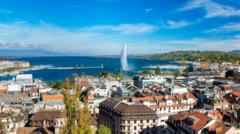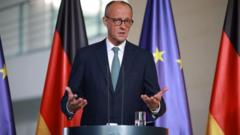Spain’s economy is thriving, boosted by tourism and modernization, with a focus on sustainability and job stability amid global economic disruptions.
Spain's Economic Boom: A Model of Resilience and Growth

Spain's Economic Boom: A Model of Resilience and Growth
Spain's robust economy stands as a beacon of success amidst challenges in Europe.
Spain attracts the second highest number of overseas visitors after France.
It's a chilly mid-winter afternoon in Segovia, in central Spain, where tourists gather around the iconic Roman aqueduct, drawn not just by its beauty but also by Segovia's rich cultural offerings and strategic location just beyond Madrid. Elena Mirón, a local tour guide adorned in a vibrant fuchsia beret, leads her enthusiastic group while reflecting on how the post-Covid tourism recovery fills her with optimism. "At one point, I thought tourism would never return, but now I’m hopeful for 2023 and 2024," she shares.
Spain welcomed a record 94 million tourists in 2024, increasingly rivaling France's 100 million, a significant factor fueling the country's impressive economic performance. The nation's GDP grew by 3.2% last year, outpacing Germany, France, Italy, and the UK. The Economist has hailed Spain as the world's best-performing economy, attributing its success to a well-balanced growth model. Business minister Carlos Cuerpo credits Spain for driving 40% of eurozone growth, highlighting the diversification of sectors contributing to the recovery.
While tourism plays a vital role, Spain’s economy has also unraveled new opportunities in sectors like technology and financial services, which have proven critical as the country rebounded from an 11% GDP contraction during the pandemic. The European Union’s Next Generation programme has granted Spain up to €163 billion by 2026, aiding public investments in rail, low-emission zones, and electric mobility initiatives.
The resilience of Spain's economy became evident as other European nations struggled due to overdependence on industry, reeling under the pressures of high energy costs and international competition. Despite challenges, including an inflation peak of 11% in 2022, Spain managed to mitigate the impact through subsidies, minimum wage adjustments, and the "Iberian exception", a cap on electricity-generating gas prices, showcasing government interventions that have buffered the population against economic shocks.
Renewable energy investments further complicate Spain's growth narrative, providing an essential foundation for the car manufacturing industry while raising expectations for the electric vehicle market. The nation's second-largest renewable energy infrastructure in the EU is a catalyst for growth, according to Wayne Griffiths, CEO of Seat and Cupra, who emphasizes the compatibility of clean energy sources with sustainable automotive production.
Yet, amidst these achievements, Spain grapples with underlying issues like high unemployment, which remains the highest in the EU at nearly double the average, although it fell to 10.6% in late 2024, its lowest since 2008. Employment levels reached a record high of 22 million, bolstered by labor reforms favoring permanent contracts.
Despite a vibrant economy, challenges remain, such as public debt surpassing annual economic output and a burgeoning housing crisis. The Spanish government, led by Prime Minister Pedro Sánchez, faces pressure as it seeks to balance growth with socio-economic stability, all while navigating an increasingly polarized political environment.
The European Commission anticipates that Spain will continue to outperform larger economies this year, but the country's heavy reliance on tourism and growing local dissent pose potential threats to long-term stability. As Spain rides the wave of economic growth, crafting solutions to these challenges will be critical in sustaining its status as Europe's economic powerhouse.
It's a chilly mid-winter afternoon in Segovia, in central Spain, where tourists gather around the iconic Roman aqueduct, drawn not just by its beauty but also by Segovia's rich cultural offerings and strategic location just beyond Madrid. Elena Mirón, a local tour guide adorned in a vibrant fuchsia beret, leads her enthusiastic group while reflecting on how the post-Covid tourism recovery fills her with optimism. "At one point, I thought tourism would never return, but now I’m hopeful for 2023 and 2024," she shares.
Spain welcomed a record 94 million tourists in 2024, increasingly rivaling France's 100 million, a significant factor fueling the country's impressive economic performance. The nation's GDP grew by 3.2% last year, outpacing Germany, France, Italy, and the UK. The Economist has hailed Spain as the world's best-performing economy, attributing its success to a well-balanced growth model. Business minister Carlos Cuerpo credits Spain for driving 40% of eurozone growth, highlighting the diversification of sectors contributing to the recovery.
While tourism plays a vital role, Spain’s economy has also unraveled new opportunities in sectors like technology and financial services, which have proven critical as the country rebounded from an 11% GDP contraction during the pandemic. The European Union’s Next Generation programme has granted Spain up to €163 billion by 2026, aiding public investments in rail, low-emission zones, and electric mobility initiatives.
The resilience of Spain's economy became evident as other European nations struggled due to overdependence on industry, reeling under the pressures of high energy costs and international competition. Despite challenges, including an inflation peak of 11% in 2022, Spain managed to mitigate the impact through subsidies, minimum wage adjustments, and the "Iberian exception", a cap on electricity-generating gas prices, showcasing government interventions that have buffered the population against economic shocks.
Renewable energy investments further complicate Spain's growth narrative, providing an essential foundation for the car manufacturing industry while raising expectations for the electric vehicle market. The nation's second-largest renewable energy infrastructure in the EU is a catalyst for growth, according to Wayne Griffiths, CEO of Seat and Cupra, who emphasizes the compatibility of clean energy sources with sustainable automotive production.
Yet, amidst these achievements, Spain grapples with underlying issues like high unemployment, which remains the highest in the EU at nearly double the average, although it fell to 10.6% in late 2024, its lowest since 2008. Employment levels reached a record high of 22 million, bolstered by labor reforms favoring permanent contracts.
Despite a vibrant economy, challenges remain, such as public debt surpassing annual economic output and a burgeoning housing crisis. The Spanish government, led by Prime Minister Pedro Sánchez, faces pressure as it seeks to balance growth with socio-economic stability, all while navigating an increasingly polarized political environment.
The European Commission anticipates that Spain will continue to outperform larger economies this year, but the country's heavy reliance on tourism and growing local dissent pose potential threats to long-term stability. As Spain rides the wave of economic growth, crafting solutions to these challenges will be critical in sustaining its status as Europe's economic powerhouse.



















